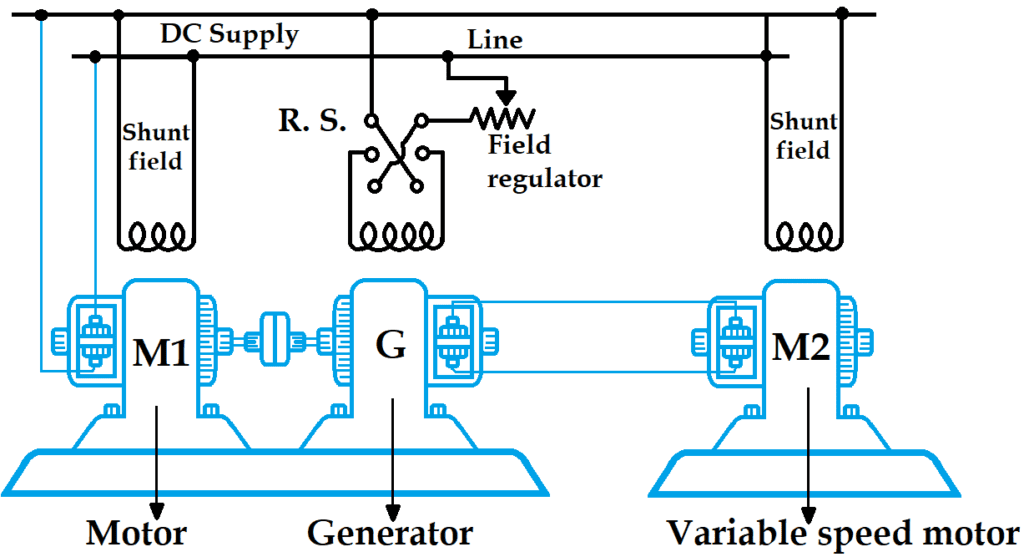Speed control of DC motors can also be achieve by varying the applied voltage to the armature. Ward-Leonard System of speed control is based on this principle. The Ward-Leonard control system was introduce in 1891 by Harry Ward Leonard.
So there are two types of voltage control methods, that is multiple voltage control method and Ward-Leonard system method. In this article we will discuss the Ward-Leonard System method. So let’s start this topic.
Ward-Leonard system
You can see the basic connection diagram of the Ward-Leonard System in the figure below.
So, M1 is the main motor whose speed control is require. The field of this motor is permanently connected to the DC supply lines. Any desired speed can be obtained by applying variable voltage to its armature. So this variable voltage is supplied by a motor-generator (M-G) set consisting of a DC or AC motor M2 connected directly to the generator G.
Ward-Leonard system diagram

Motor M2 runs at a nearly constant speed. The output voltage of G is fed directly to the main motor M1. The voltage of the generator can be varied from zero to its maximum value by means of its field regulator.
By reversing the direction of filed current of G through the reversing switch RS, the generated voltage can be reversed and hence the direction of rotation of M1.
A modification of the Ward-Leonard system is also known as Ward-Leonard-Ilgner system which uses a small motor-generator set with that includes a flywheel whose function is to reduce fluctuation in the power demand from the supply circuit.
When the main motor M1 is suddenly overloaded, the driving motor M2 of the motor generator set slows down, thus allowing the inertia of the flywheel to supply a portion of the overload. But When the load is suddenly dropped from the main motor M1, the speed of M2 increases, and again energy is stored in the flywheel.
When driven by means of an AC motor (whether induction or synchronous) a further refinement can be usefully employed in the form of an Ilgner system ‘slip regulator’, thus giving an additional control.
Note :
The capital outlay involved in this system is high because (1) a large output machine must be use for the motor generator set and (2) that two extra machines are employ, still it is use extensively for lift, hoist control and for main drive in steel mills where motor of ratings 750 kW to 3750 kW are require.
This is because virtually unlimited speed control in any direction of rotation can be achieve entirely by field control of the generator and the resultant economics in steel production more than outweighs the additional expense on the motor generator set.
One more thing Remember that the motor generator set always runs in the same direction.
What are the applications of Ward-Leonard system?
The Ward Leonard system is use where unusually wide (up to 10 : 1) and very sensitive speed control is require such as for colliery winders, electric excavators, elevators and main drives in steel mills and blooming and paper mills.
Advantages of Ward-Leonard system
- The speed regulation of DC motor in this system is good.
- This system has inherent regenerative braking capacity.
- It has the excellent ability of giving wide speed control from maximum in one direction through zero to the maximum in the opposite direction and of giving a smooth acceleration.
Disadvantages of Ward-Leonard system
- The main disadvantage of this system is its low overall efficiency, especially at light loads.
- This system is expensive as two additional machines (M-G set) are require.
- Due to the large size, more floor area is require
- More noise is generate.
- It has large weight.
See also this article :
1. What are the methods of speed control of dc motor – Shunt and Series motor
2. What are the characteristics of DC motor? – Shunt Motor, Series Motor, Compound Motor
3. What is torque in DC motor? – Define armature torque and shaft torque of DC motor
4. What is DC motor? – Principle, Working, Types, Back emf, Significance
5. What is the DC generator? : Construction, Working principle, Types, EMF equation, Losses
So, I hope this information will help you. Thank you
